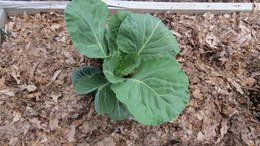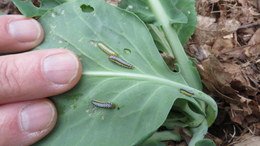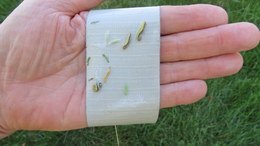Collards Growing Guide
Collards (Brassica oleracea) also called collard greens are one of the cruciferous vegetables you should eat on a regular basis and is an important source of essential nutrients and fiber. They are a member of the cabbage family. It has a loose leaf and does not form a head and is the official vegetable of South Carolina.
Collards are very popular with southern gardeners and are grown throughout the south. They are a cool-weather vegetable that can tolerate temperatures in the upper teens and are one of the few vegetables that should be planted before the last frost in the spring. Planting in the fall is very popular due to their cold tolerance and that the leaves are sweeter when they are touched by the frost.
It contains a compound called sulforaphane. Sulforaphane belongs to a group of phytochemicals that are reported to be helpful in the prevention of cancer.
A partial list of cruciferous vegetables is: bok choy (Chinese cabbage), broccoli, Brussels sprouts, cabbage, cauliflower, collards, kale, kohlrabi and radish.
Most varieties are a biennial and as you harvest the lower leaves you will have a cluster of leaves at the top of a hard fibrous stalk, 1 to 4-feet tall looking somewhat like a miniature palm tree.
Starting From Seed
Seeds can be planted directly in the garden in the early spring when the soil reaches 40 to 45-degrees F and will germinate in 7 to 10-days. Plant the seeds 1/4 to 1/2 -inch deep and 1 to 2-inches apart in rows 18 to 24-inches apart. Thin to 18 to 24-inches apart. The plants that are removed can be eaten or transplanted to expand your crop.
Plants can also be started indoors and set out in the garden 6 to 8-weeks before the last frost spaced 18 to 24-inches apart.
For more detailed information visit the seed starting page.
The leaf growth starts out slowly, but will soon take off after the roots get established. Be patient and keep the soil moist and do not let them dry out.
For fall planting, direct seed about 3-months before the first average frost. When touched by frost the flavor improves. They can withstand temperatures in the high teens to low 20s with a light row cover.
Soil Preparation
The soil should be nice loose well drained organic garden soil with the soil pH between 6.5 to 6.8. As soon as the soil is frost-free and can be worked, till the soil by digging down 8 to 12-inches turning the soil over with a garden fork. Remove any large rocks and stones. The small stones remaining will do no harm and actually benefit the soil by adding some micronutrients to the soil.
Planting
They are a cool weather annual vegetable and can be planted in the garden 3 to 4-weeks before the last frost. Plant them in an area that gets 6 to 8-hours of sun. When transplanting into the garden they can be planted deeper just like tomatoes. The collards will form roots along the stem. The plant spacing should be 18 to 24-inches apart.
Watering and Care
When the plants are a few inches tall add a nice loose mulch of shredded leaves or pine straw to shade the plant roots. This will keep the weeds out, the soil cooler and help retain moisture. Keep the mulch a couple of inches away from the stem. They should get about an inch of water per week and during dry spells give some water each week.
If needed you can feed with an organic fertilizer such as Espoma Garden-tone.
Harvesting Collards
Collards mature in about 45-days, but if you started your plants from seed you can start by thinning and removing any plants that are too close to others to give them more room to grow. On young plants, be careful when removing leaf stalks. You do not want to pull the plant out of the ground or disturb its roots. Use a sharp knife to cut 1 or 2 outer leaf stalks at the base of each plant taking care not to injure the new leaves growing from the central crown.
Established collards are very frost tolerant down to the low 20-degree range and will continue to grow. The taste of collard greens improves after a light frost.
Depending on your growing zone you may be harvesting up to and perhaps past Christmas. A light row cover can be used to cover your plants overnight to give some protection on the heavier frost nights.
The younger leaves are tender and have better flavor. Pick them before they are 10-inches long, the older leaves tend to get stringy.
It is very important not to overcook collard greens or any of the other cruciferous vegetables. Sulforaphane contains sulfur, which is essential for life. When collard greens and other cruciferous vegetables are overcooked, they will emit an unpleasant sulfur smell, which is why many people do not like collard greens, broccoli or cabbage.
Diseases
There are several diseases that affect the cruciferous vegetables. These occasionally affect the roots and leaves. Crop rotation and removal of diseased plants is the best way to control them. Increasing plant spacing in the future helps increase air circulation around the plants.
Pests
Most of the cruciferous vegetables are all affected by many of the same pests. Some of these are: aphids and several species of cabbageworms and caterpillars.
The easiest way to deal with aphids without using chemicals is to knock them off with a spray of water. Ladybug beetles will eat many aphids. Many gardeners will purchase them and release them in their garden to help control the aphids that are a problem with many plants. Serious infestations can be controlled with an organic product such as insecticidal soap or neem oil. These are both organic controls that are very effective.
The cabbageworms and caterpillars cause damage by eating holes in the leaves. The adult moth lays small eggs on the underside of the leaves, which hatch out as larvae and do the damage. They multiply very rapidly, so inspect your plants often early in the morning, between the leaves and the underside for small caterpillars and egg masses.
Cabbageworms can be removed by hand picking them as you inspect your plants. Spraying your plants every 1 or 2-weeks with a special variety of BT (Bacillus thuringiensis var. kurstaki) will kill the cabbageworms. There are also several products that contain spinosad, a naturally occurring insecticide.
Duct tape helps to remove the caterpillars and eggs. Take a piece about 8 or 9-inches long and attach the ends together to form a loop with the sticky side out. Put one hand through the loop and with the other lift up a leaf looking for any caterpillars or eggs. If you find any caterpillars stick them to the tape and do the same for the eggs.
Cabbage root maggot larvae feed on the roots of the plants, which in the beginning causes wilting and plants to die later on. The best prevention is to toss the entire plant in the garbage after harvesting, including any soil that clings to the roots. The best way to reduce any future problems is to rotate your crops to a new location each year. Row covers are about the only way to control the cabbage root fly. Place the row covers over the plants in the spring right after putting them in the ground.
Popular Varieties
Popular cultivars include Cash Crop, Champion, Flash, Georgia, Morris Heading, Top Bunch, Vates.
Sources: Seeds Now, Eden Brothers, Seed Savers Exchange.
Garden Spikes newsletters give you timely information once or twice a month. Subscribe Free to the Garden Times newsletter below.
Your email address will only be used to send you a newsletter and will never be sold. You can unsubscribe at any time.



